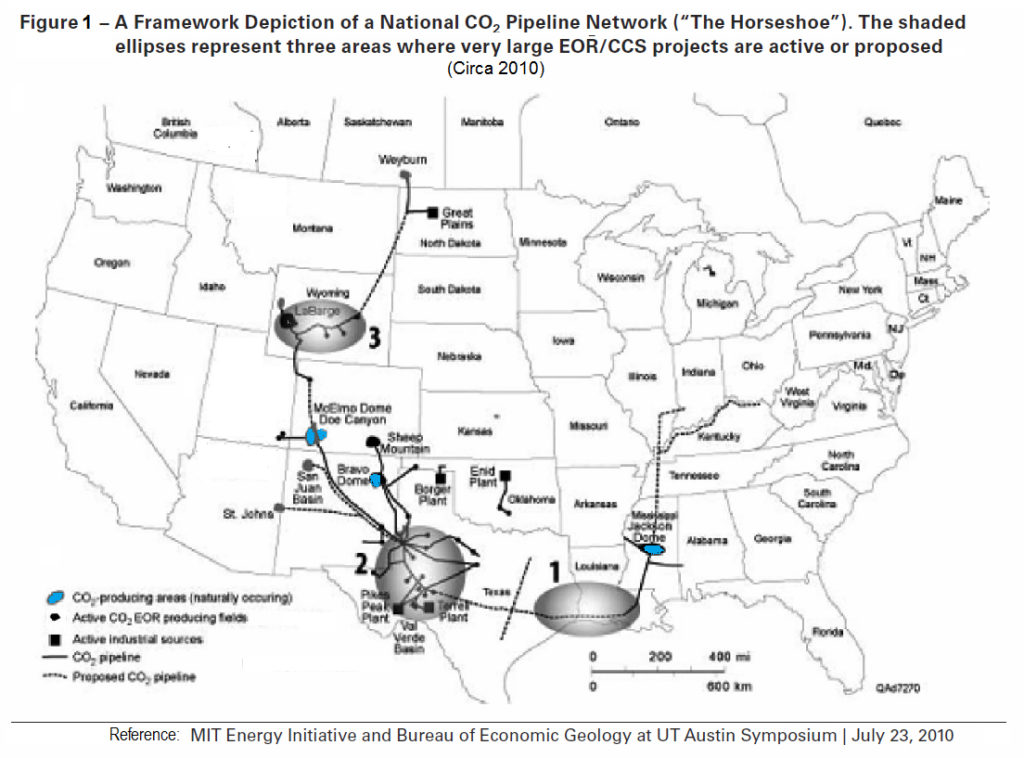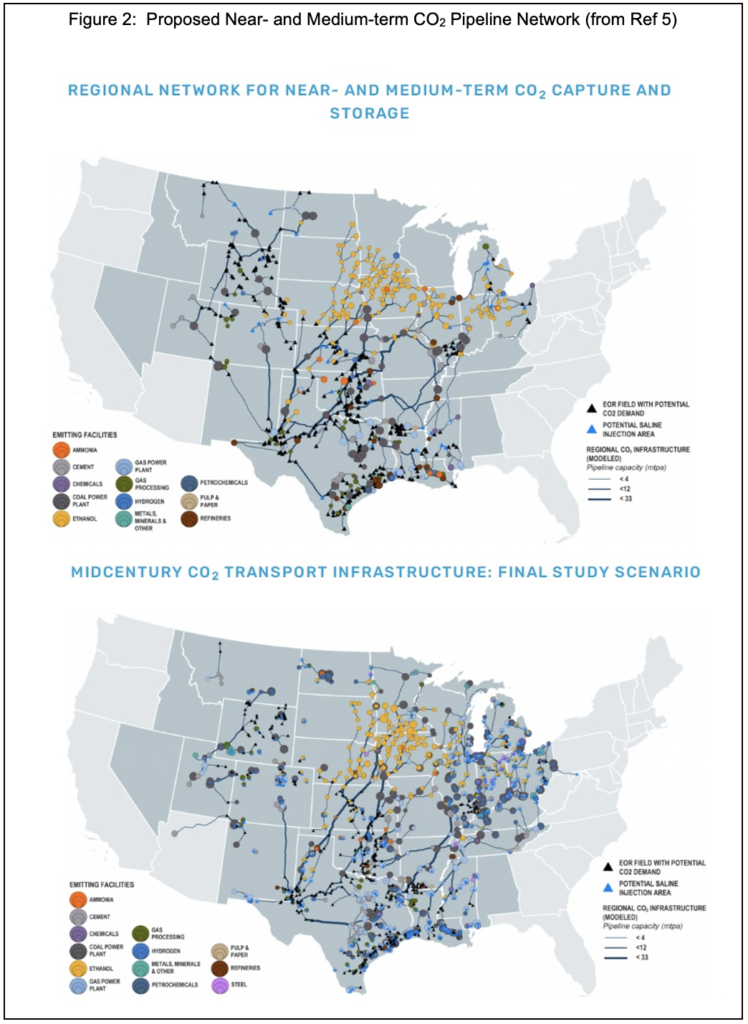The content of this tab on Secure Storage of CO2 is summarized in a March 2023 recorded fireside chat at the US Energy Association. The link to that recording is provided here:
If you prefer not to download the above file, the following text is a nice summary of the considerations one must address and model as geologic storage sites around the country and world are being considered for secure geologic storage.
The selection of actual sites for secure and long-term geologic storage of carbon dioxide has only been a quiet, background subject of discussion for a decade or so. Perhaps ‘just quietly’ since overpressuring subsurface formations to dispose of surface captured CO2 creates some worry that some will escape back to the surface. Concerns regarding imperfect seals above the injection intervals or inadequately cemented wellbores are often mentioned. Other risk factors are also present and addressed in this downloadable document. When considering the large volume CO2 injections, those worries have led to extensive regulations in the form of a new class of Underground Injection Council (UIC) wells, i.e., Class VI wells. It is fair to say that some trepidation is occurring on the part of Federal and State regulators; very few Class VI wells has have been permitted although the regulations for Class VI wells were codified in 2012.
In the interest of an accelerated pace of capture of industrially sourced greenhouse gases, industry has an alternative. Fortunately, CO2 Injection and CO2 injection well designs have been field tested in CO2 enhanced oil recovery operations since 1972. It is important to note that the reservoirs in which the wells are operative are not overpressured since fluids and mass balancing of injected and produced volumes are carefully monitored.
Also fortunately, the idea of injecting large volumes of CO2 to reduce atmospheric emissions involves a host of existing and field proven CO2 capture, purification, compression, transportation and injection technologies. As the scale of capture and injection continues to advance, it will require very large volume reservoirs with proven seals. Relatively pure CO2 will be required and be placed at minimum depths of 3000-4000 feet to reach what the chemists like to call carbon dioxide’s dense or critical state. Further needs require adequate pore space in reservoirs with excellent lateral continuity and free from transmissive natural fractures to the surface. All of these requirements will favor certain geological basins (Refs 1-4). The more proven the sites are for permanent storage, the lower the risk profile on the very large investment dollars required for both the capture and the storage. Those favored storage basins and sites will require a CO2 transportation network of pipelines to connect the emission sources with the secure geologic storage sites.
Many studies conducted over the past 15 years have documented the large volume emission sources of CO2 (refs 5-8). Many lie far distances from the preferred basins for storage. In the U.S., the best options for connecting the emission sites with the storage locations must involve the integration of both existing and future CO2 pipeline infrastructure. The existing CO2 pipeline network evolved to commercially transport of CO2 to enhanced oil recovery projects. One of the first studies on the subject of connected the existing pipelines with newly constructed lines was reported in a MIT Energy Initiative report entitled “Role of Enhanced Oil Recovery in Accelerating the Deployment of Carbon Capture and Sequestration” (Ref 9, July 2010). Figure 1 is a map from the report and the pipeline network presented took maximum value from the existing CO2 pipelines. It necessarily added several key connection lines to form what was referred to as the “Horseshoe” pipeline network. A key point was made that multiple proven basin setting storage sites for the future carbon capture plants was the best way to assure the capturing industry investments would proceed and not be reliant on unproven storage sites closer to the capture plants. The void in the central U.S. was recognized at the time as an immense challenge without both capture and pipeline construction incentives.
Additional and more extensive CO2 pipeline work has been performed since the 2010 report. Figures 2 (Ref 10) and 3 (Ref 5) are two such examples. Note that each relies on connecting the Midwestern U.S. and Gulf Coastal sources of CO2 to the Permian Basin’s host of existing and future storage sites.

Summary: The successful CO2 capture, pipeline, and injection industry that has evolved over the past 45 years for CO2 enhanced oil recovery are poised to take on the challenge of industrial carbon capture and subsurface storage. Incentives for the capture have now been put into place and Federal and State assistance with expanding the transportation pipelines is being discussed. Networking the new pipelines with the vast area of existing CO2 pipelines will eliminate most of the economic and technical risks of carbon capture, removal, utilization, and storage.

References
-
- Hitchon et al, Dynamic basin analysis: an integrated approach with large data bases, Geological Society, London, Special Publications 1987, 34:31-44
-
- Hitchon et al, The role of hydrogeological and geochemical trapping in sedimentary basins for secure geological storage of carbon dioxide, Geological Society, London, Special Publications 2004, 233:129-145
-
- Hitchon B, Gunter WD, Gentzis T, Bailey RT (1999), “Sedimentary basins and greenhouse gases: a serendipitous association” Energy Conversion & Management 40:825–843
-
- Above references briefly summarized in a recording of a presentation available for viewing https://melzerconsulting.com/wettability/
-
- Abramson, E., McFarlane, D. & Brown, J. (2020), “Transport Infrastructure for Carbon Capture and Storage, Whitepaper On Regional Infrastructure For Midcentury Decarbonization,” Great Plains Institute, June 2020 https://www.betterenergy.org/wp-content/uploads/2020/06/GPI_RegionalCO2Whitepaper.pdf
-
- https://scitechdaily.com/scientist-maps-co2-emissions-for-entire-us/
-
- Ming, M. & Melzer, L.S. (2010) “CO2 EOR: A Model For Significant Carbon Reductions” in Symposium on the Role of EOR in Accelerating the Deployment of CCS, MIT Energy Initiative, 7-23-2010, pp 75-89.
